|
 |
|
|
|
 |
|
 |
|
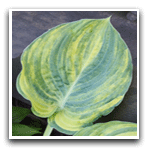 Sexual
Reproduction
involves the mixture of male genetic material in the
form of pollen with the female genetic material in
the ovary of the flower. This results in the
production of seeds, each of which has a slightly
different mixture of the genetic material of the
male and female. The pollen and ovary may be on two
different plants which is called
cross-pollination
or, in the case of self-pollination, both originate
on the same plant. The results of both types are called hybrid or
seedling hostas. Sexual
Reproduction
involves the mixture of male genetic material in the
form of pollen with the female genetic material in
the ovary of the flower. This results in the
production of seeds, each of which has a slightly
different mixture of the genetic material of the
male and female. The pollen and ovary may be on two
different plants which is called
cross-pollination
or, in the case of self-pollination, both originate
on the same plant. The results of both types are called hybrid or
seedling hostas. |
|

The parentage or background of hybrid hostas may be identified
in several different forms. The amount of information
provided depends on the personal knowledge or records
kept by the person who "originated" the new cultivar.
Here are ways you might see the background of a hybrid
hosta represented in catalogs, books, articles or on the
AHS
registration application.
|
|
 |
H. 'Blue Angel'
× H. 'Big Daddy'
is in the standard format:
pod (female) parent ×
pollen (male) parent.
(The symbol between the two is not an X but is a
multiplication sign ×.)
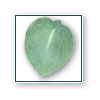 This tells us that
the seeds came from 'Blue Angel' and the pollen
originated from 'Big Daddy' in an example of
cross-pollination. To know
the ancestry for
certain, it would have been a case where the
hybridizer gathered the pollen from 'Big Daddy' and
physically applied it to the pistil (female part) of
a flower of 'Blue Angel'. The plants were labeled
somehow to be able to identify them and records were
kept. This tells us that
the seeds came from 'Blue Angel' and the pollen
originated from 'Big Daddy' in an example of
cross-pollination. To know
the ancestry for
certain, it would have been a case where the
hybridizer gathered the pollen from 'Big Daddy' and
physically applied it to the pistil (female part) of
a flower of 'Blue Angel'. The plants were labeled
somehow to be able to identify them and records were
kept.
|
|
 |
H. 'Blue Angel'
× H.
'Blue Angel' shows an example of a
self-pollinated hybrid.
The pollen from 'Blue Angel' was collected by a
person and physically transferred to the pistil of
the same plant. Records were kept to document the
transaction.
|
|
 |
H. 'Blue
Angel' × Unknown
represents a case where the hybridizer collected
seed from 'Blue Angel' but does not know the source
of the pollen. Bees, rather than humans did the
pollinating. This is called an
open-pollinated hybrid.
|
|
 |
1. Unknown ×
H. 'Blue Angel'
is an infrequently encountered scenario. It
shows that a hybridizer took pollen from 'Blue
Angel' and then applied it to the pistil of an
unnamed plant. Here, the pod parent is unknown and
the pollen parent is 'Blue Angel'.
|
2. Unknown -
Occasionally, neither the pod or pollen parent have
been identified for a cultivar. Perhaps the person
harvested some seeds from random plants in their
garden or at a horticulture garden. The seeds may
have been a gift from someone who lost track of
their origin. Either way, these plants are sometimes
described as having a certain plant in their "background"
as described below.
|
|
 |
At times, the name of the specific pod parent,
pollen parent or both parents of a new hybrid hosta
are not available but some of its ancestors are
known. When using so-called "breeder" plants,
hybridizers may not name the actual plant being used
but they do know its genetic background. These are
then cited in the development of the new cultivar
and are called a Complex Cross.
This is often similar to telling you that a baby
named Jane Doe was born to a woman whose paternal
grandparents were Bob Smith married to Barb Sweet
and maternal grandparents were Joe Schultz and wife
Mary Roberts. The father was the grandson of Bill
Ford married to Lynn Wright and Jerry Moore and wife
Betty Long. This would be shown as:
[(Mary Roberts × Joe
Schultz) × (Barb Sweet × Bob Smith)] ×
[(Lynn Wright × Bill Ford) ×
(Betty Long × Jerry Moore)]
What were the names of Jane Doe's parents?
Answer: Unknown
The following are some examples of the various
ways Complex Crosses are presented to show the
genetic background of new hosta cultivars.
|
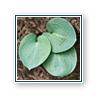 1. H. 'Blue
Angel' ×
"RD-42-09" is an example of the use of
a
"breeder" plant by an individual hybridizer.
Technically, it does not have a true
cultivar name so it is shown in quotation marks. The
hybridizer had a plant developed in his or her
hybridizing program which had certain traits
desirable for mixing with H. 'Blue Angel'.
However, for some reason only known to the
hybridizer, "RD-42-09" did not warrant being given a
unique
cultivar name. It is shown as the pollen parent but,
in reality, that parent should be listed as unknown
since this hosta does not have an actual cultivar
name. 1. H. 'Blue
Angel' ×
"RD-42-09" is an example of the use of
a
"breeder" plant by an individual hybridizer.
Technically, it does not have a true
cultivar name so it is shown in quotation marks. The
hybridizer had a plant developed in his or her
hybridizing program which had certain traits
desirable for mixing with H. 'Blue Angel'.
However, for some reason only known to the
hybridizer, "RD-42-09" did not warrant being given a
unique
cultivar name. It is shown as the pollen parent but,
in reality, that parent should be listed as unknown
since this hosta does not have an actual cultivar
name.
|
2.
(H. 'Blue Angel'
× H. 'Big
Daddy') × H.
'Amos' is another form of a
complex cross. In this
example, we know that the pollen (father) parent is 'Amos'. However, we only know the
grandparents
on the mother's side and do NOT know the name of the pod
parent. Technically the parentage of this hosta
should read pod parent unknown and pollen parent
H. 'Amos'
|
3. (H. 'Blue
Angel' × H. 'Sea Prize') ×
(H. 'Big Daddy' × H.
'Halcyon') is another
complex cross that only
identifies the grandparents
of the new cultivar but NOT the parents. Technically
the parentage of this hosta should read pod parent
unknown and pollen parent unknown i.e. Unnamed
Seedling × Unnamed Seedling.
|
4.
[(H. 'Blue Angel' ×
H. 'Sea Prize') × (H. 'Big Daddy' × H.
'Halcyon')] ×
[(H.
'Tot Tot' × H. 'Fortunei') × (H. 'Elegans'
× H. 'Invincible')] is
another complex cross
that only identifies the
great grandparents of the new cultivar.
The grandparents
would be (Unnamed Seedling × Unnamed Seedling) ×
(Unnamed Seedling × Unnamed Seedling) and the
parents of the new cultivar would be Unnamed
Seedling × Unnamed Seedling.
|
 Click
Here for a list of hybrid hostas that have a
Complex Cross listed as one or more of the parent
plants. Click
Here for a list of hybrid hostas that have a
Complex Cross listed as one or more of the parent
plants.
|
|
 |
|
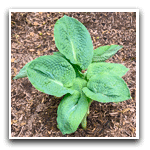 Asexual Reproduction
occurs when a part of the original or mother plant
"spontaneously" changes characteristics.
In hostas, this generally occurs in a change of the
leaf color pattern. One spring in the garden, you
find a set of leaves on a green plant that have a
yellow marginal variegation. If you carefully cut
that part of the plant away, you can grow the new
division as a separate plant. This also occurs in
the micro-propagation technique called
tissue
culture. In recent decades, a large percentage of
new cultivars of hostas are being discovered during
this process. These new plants are called sports and
may be further designated as garden sports or tissue
culture sports. Asexual Reproduction
occurs when a part of the original or mother plant
"spontaneously" changes characteristics.
In hostas, this generally occurs in a change of the
leaf color pattern. One spring in the garden, you
find a set of leaves on a green plant that have a
yellow marginal variegation. If you carefully cut
that part of the plant away, you can grow the new
division as a separate plant. This also occurs in
the micro-propagation technique called
tissue
culture. In recent decades, a large percentage of
new cultivars of hostas are being discovered during
this process. These new plants are called sports and
may be further designated as garden sports or tissue
culture sports. |
|
 |
|
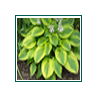 Sport Mother Plants
- In the vast majority of cases, the plant from
which a sport is taken is identified as the mother
plant. Sometimes when one is found in a garden
situation, the mother plant may be unlabeled or not
named but this is not usually the case. Sport Mother Plants
- In the vast majority of cases, the plant from
which a sport is taken is identified as the mother
plant. Sometimes when one is found in a garden
situation, the mother plant may be unlabeled or not
named but this is not usually the case. |
 |
|
 |
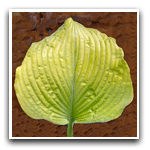 Background - In
some cases, the information just says that the
cultivar has H. 'Blue Angel', H. 'Sea
Prize', H. 'Big Daddy' and H.
'Halcyon' in its background or that these plants
were used in an unspecified hybridizing program. Or,
it may note physical similarities and surmise that a
certain hosta is likely to be in the background
Technically the parentage of this hosta should read
pod parent unknown and pollen parent unknown. Background - In
some cases, the information just says that the
cultivar has H. 'Blue Angel', H. 'Sea
Prize', H. 'Big Daddy' and H.
'Halcyon' in its background or that these plants
were used in an unspecified hybridizing program. Or,
it may note physical similarities and surmise that a
certain hosta is likely to be in the background
Technically the parentage of this hosta should read
pod parent unknown and pollen parent unknown.
|
|
 |
Sibling - When a
hybridizer gathers seeds from hostas, they come in
pods which contain many individual seeds. They may
plant all of the seeds from one pod parent and then
evaluate dozens or more seedlings. Generally, they
throw away almost all of them and may choose one or
more (or none) as worthy of being named. When
multiple seedlings are named from the same breeding,
they would be called siblings. Of course, since each
seed was developed from a different egg fertilized
by different pollen, they would NOT be genetically
identical. It is the same as a human family of six
children with the same parents.
During tissue culture (TC) propagation, hundreds and
perhaps thousands of clones are produced from a
small amount of tissue from a single hosta. Each one
of these new plants "should" be identical to all the
others. However, due to the use of plant hormones
and other chemicals during the process, a small
percentage of the resulting plants will have
different traits from the mother plant. If two or
more of these plants from the same TC batch are
given names, these would also be considered as
siblings.
|
|
 |
"Type" Plants - A
commonly used way to help identify a cultivar,
especially if it is of
unknown parentage, is to call
it a certain "type" based on its physical traits.
Commonly used examples include 'Sieboldiana'-type, 'Fortunei'-type
or Tardiana-type. This gives a general "feeling" for the
cultivar's size, leaf color or other characteristics
but does not identify its actual parentage.
|
|
|



